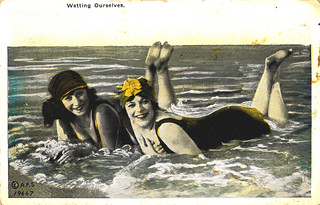



The economic reality is that Nova Scotia has been one of the "have not" provinces for more than a century, and Nova Scotians and other Maritimers have been leaving for greener pastures ever since Canadian prosperity moved westward at the end of the Age of Sail (it's a well-worn cliche that the most important export of the Maritime provinces is brains). Nova Scotians have a long history of entanglement with New England, the "Boston States", including migration streams in both directions. This collection showcases the mid-19th century to early-20th century Bluenose outmigration to centers of opportunity, and reflects a time when it was easy to travel between Nova Scotia and Boston by overnight packet steamer, and when jobs were plentiful for educated men and women.
When I moved to Nova Scotia in 1972, the province seemed quite peripheral to the North American continent. Few franchise retail and food establishments had invaded the landscape, limited access highways and long-distance commuting were not common features of daily life for most people, and the plague of malls and subdivisions was just beginning. Cities and towns (except for the Halifax metropolitan area) were mostly composed of people who had grown up knowing each other, and most people chose spouses from their own or nearby communities. People "from away" were in the minority, even if "away" meant from the next county. Many households were still in the 1950s materially. Nova Scotians were beginning to want modern conveniences and luxury goods, but they had to travel to find them.
The population of 1970s Nova Scotia still included many people born in the 19th century and plenty of people with adult memories of the Dirty Thirties. The generation who had fought in the trenches in France animated the obituary columns, and those who had fought in WW II were entering late middle age. It seemed to me, as an in-migrant from California, to be almost a traditional or even a folk society, based in the sort of face-to-face relationships and complex calculus of personal and family reputation that had once enlivened small-town life all over North America.
I set about a project of mapping surname territories, as a first effort to grasp the structure and dynamics of regions within the province. These two maps sketch some of the delicious complexities (at some point I'll add links to the surname geography work, which intersects in a number of interesting ways):


Nova Scotia's regional subdivisions are quite distinct, and in most cases still reflect the 18th century history of settlement, though with modifications induced by 20th century migrations. In the 19th century it's quite clear that nearly all residents of Lunenburg County were descendants of dependable Protestant migrants from the German Palatinate. These two gentlemen wear very distinctive headgear, which I think of as "Lunenburg hats"




For the geographically curious, there's a fine map of Nova Scotia place names in pdf form (use the zoom function to see details).